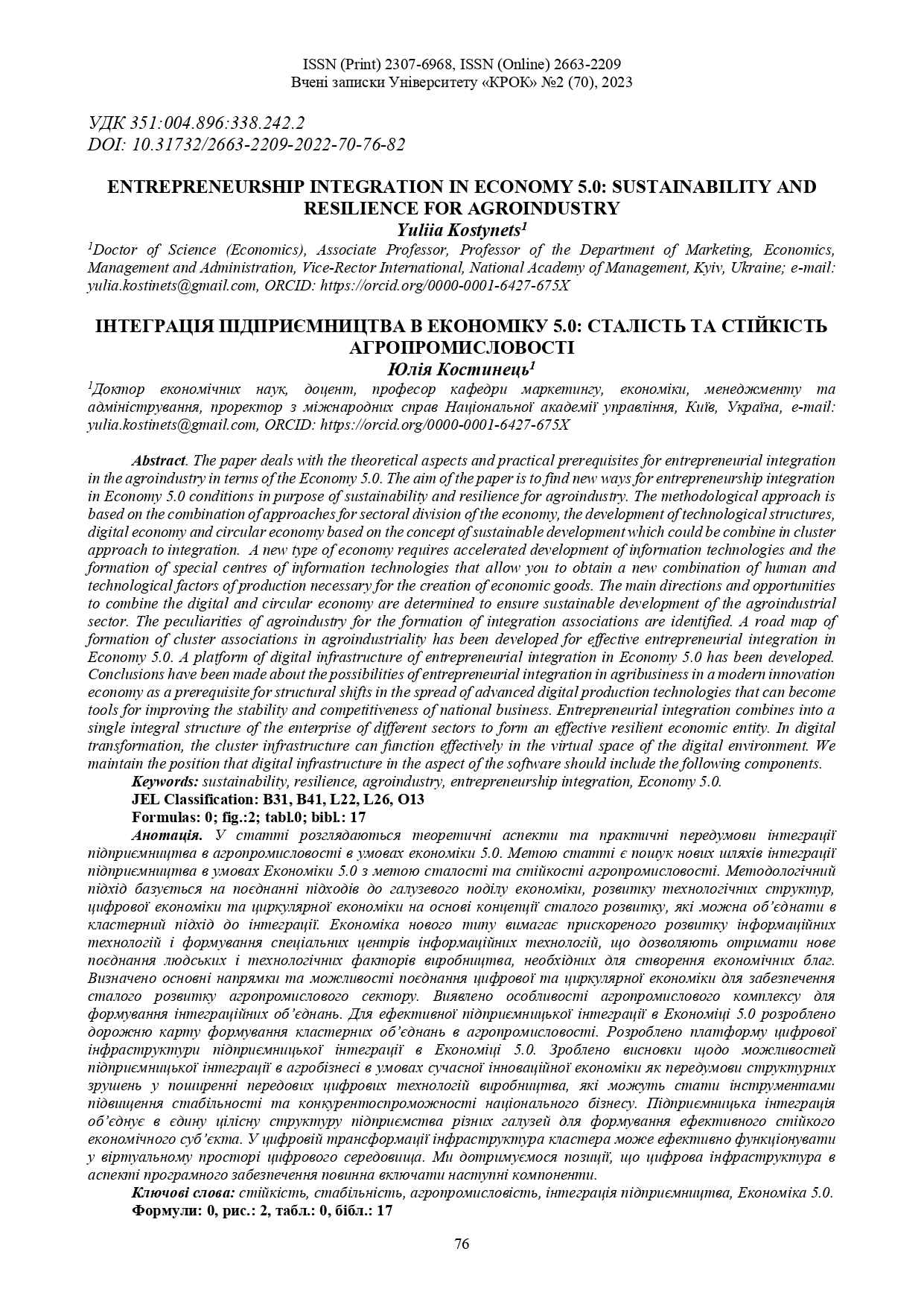ІНТЕГРАЦІЯ ПІДПРИЄМНИЦТВА В ЕКОНОМІКУ 5.0: СТАЛІСТЬ ТА СТІЙКІСТЬ АГРОПРОМИСЛОВОСТІ
DOI:
https://doi.org/10.31732/2663-2209-2022-70-76-82Ключові слова:
стійкість, агропромисловість, інтеграція підприємництва, Економіка 5.0, стабільністьАнотація
У статті розглядаються теоретичні аспекти та практичні передумови інтеграції підприємництва в агропромисловості в умовах економіки 5.0. Метою статті є пошук нових шляхів інтеграції підприємництва в умовах Економіки 5.0 з метою сталості та стійкості агропромисловості. Методологічний підхід базується на поєднанні підходів до галузевого поділу економіки, розвитку технологічних структур, цифрової економіки та циркулярної економіки на основі концепції сталого розвитку, які можна об’єднати в кластерний підхід до інтеграції. Економіка нового типу вимагає прискореного розвитку інформаційних технологій і формування спеціальних центрів інформаційних технологій, що дозволяють отримати нове поєднання людських і технологічних факторів виробництва, необхідних для створення економічних благ. Визначено основні напрямки та можливості поєднання цифрової та циркулярної економіки для забезпечення сталого розвитку агропромислового сектору. Виявлено особливості агропромислового комплексу для формування інтеграційних об’єднань. Для ефективної підприємницької інтеграції в Економіці 5.0 розроблено дорожню карту формування кластерних об’єднань в агропромисловості. Розроблено платформу цифрової інфраструктури підприємницької інтеграції в Економіці 5.0. Зроблено висновки щодо можливостей підприємницької інтеграції в агробізнесі в умовах сучасної інноваційної економіки як передумови структурних зрушень у поширенні передових цифрових технологій виробництва, які можуть стати інструментами підвищення стабільності та конкурентоспроможності національного бізнесу. Підприємницька інтеграція об’єднує в єдину цілісну структуру підприємства різних галузей для формування ефективного стійкого економічного суб’єкта. У цифровій трансформації інфраструктура кластера може ефективно функціонувати у віртуальному просторі цифрового середовища. Ми дотримуємося позиції, що цифрова інфраструктура в аспекті програмного забезпечення повинна включати наступні компоненти.
Завантаження
Посилання
Industry 5.0, a transformative vision for Europe (2022) Available at: https://research-and-innovation.ec.europa.eu/knowledge-publications-tools-and-data/publications/all-publications/industry-50-transformative-vision-europe_en
Resilient Industries: Competitiveness in the Face of Disasters (2020). Available at: https://documents1.worldbank.org/curated/en/682501604040773738/pdf/Resilient-Industries-Competitiveness-in-the-Face-of-Disasters.pdf
Fisher A.G.B. (1939) Primary, Secondary, Tertiary Production. Economic Record.
Smith, A. (1976) The Wealth of Nations edited by R. H. Campbell and A. S. Skinner, The Glasgow edition of the Works and Correspondence of Adam Smith
Rostow W. (1960) The Stages of Economic Growth: A Non - Communist Manifesto.
Kostynets V.V. (2015) Theoretical aspects of management of development market development in the national economy. Scientific Bulletin of the International Humanities University, 14, 70-73 (in Ukrainian)
Bergman Е., Feser Е. (2020) Industrial and Regional Clusters: Concepts and Comparative Applies. Avaliable at: http://www.rri.wvu.edu/WebBook/Bergman-Feser/chapter2.htm
Kobets EA (2007) Historical aspects of integration development, its forms and directions. State and regions. Economics and Entrepreneurship Series. 2007, 2, 129-133 (in Ukrainian)
Shamanskaya O. (2012) Theoretical bases of formation and development of agro -industrial integration. Effective economy. 12, Available at: http://www.economy.nayka.com.ua/?op=1&z=1632 (in Ukrainian)
Fedotova Yu.V. (2014) The role of public administration in the implementation of clustering processes at macro and mesoeconomic levels. Utilities of cities: scientific and technical collection. Series: Economic Sciences, 113, 240 – 245 (in Ukrainian)
Pushkar T. (2011) World experience in the formation and development of network and cluster associations. Economic Journal – XXI, 11/12, 68-71 (in Ukrainian)
Dolzhanskii I. (2006) Enterprise competitiveness, Kiev: Center for Educational Literature, 2006, 384 (in Ukrainian)
Fishchuk V. (2017) Digital infrastructure of economic growth. New Time. Available at: https://biz.nv.ua/ukr/ experts/fichuk/tsifrova$infrastruktura$ekonomichnogo$ zrostannja$1408403.html (in Ukrainian)
Porter M. E. (1998) Competitive Strategy: Techniques for Analyzing Industries and Competitors. New York: The Free Press, 397.
Mihus, I., & Koval, Y. (2021). Innovative development of enterprises in the conditions of digitalization of the economy. Science Notes of KROK University, (2 (62), 159–165. https://doi.org/10.31732/2663-2209-2021-62-159-165.
Mihus, I. (2023). The main trends in the development of industry 4.0 and its impact on the economic security of the state: an international aspect. Science Notes of KROK University, (1(69), 52–59. https://doi.org/10.31732/2663-2209-2022-69-52-59.
Mihus, I., Gupta, S.G. (2023). The main trends of the development of the digital economy in the EU countries. The development of innovations and financial technology in the digital economy:monograph.OÜ Scientific Center of Innovative Research. 2023. 230p.PP. 23-41, https://doi.org/10.36690/DIFTDE-2023-23-41.

Downloads
Опубліковано
Як цитувати
Номер
Розділ
Ліцензія

Ця робота ліцензується відповідно до Creative Commons Attribution-NonCommercial 4.0 International License.

